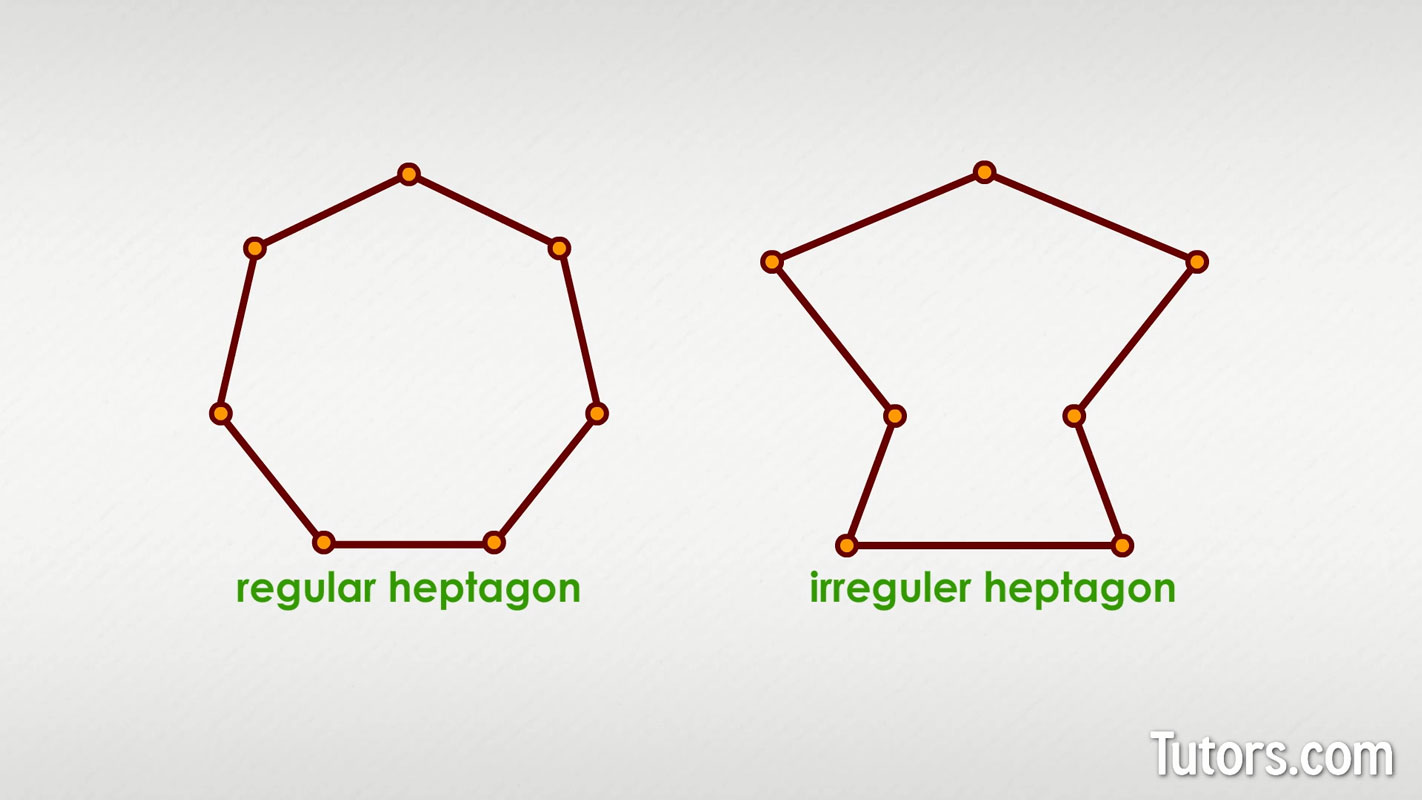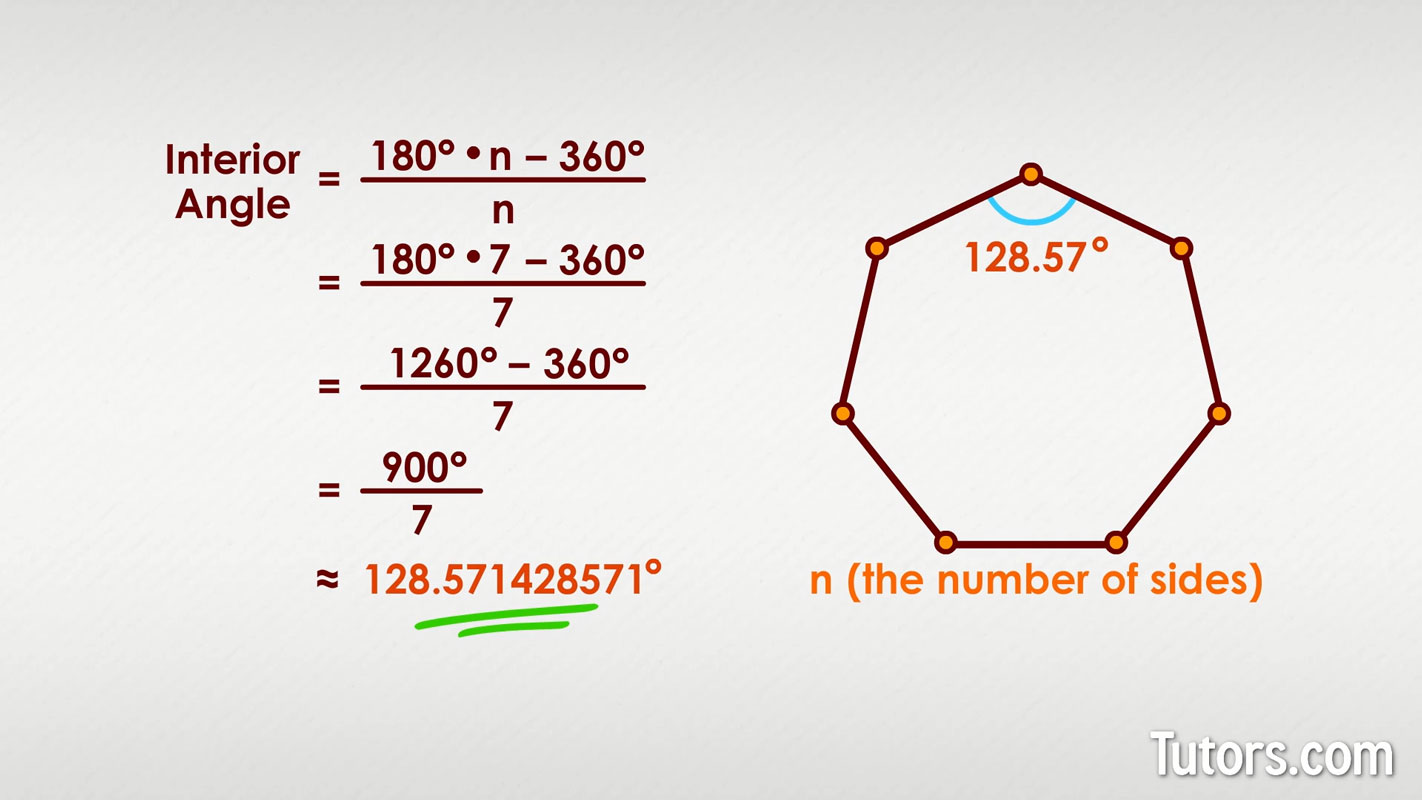Heptagon — Definition, Sides, Angles, and Examples
What is a heptagon?
A heptagon is a 7-sided polygon with 7 interior angles that sum to 900°. The name heptagon derives from the Greek words hepta- for seven and gon- for sides. A heptagon is also called a 7-gon or septagon (septa- is Latin for seven).
Heptagon shape
The heptagon shape is a plane or two-dimensional shape comprised of seven straight sides, seven interior angles, and seven vertices.

A heptagon shape can be regular, irregular, concave, or convex.

Here are some additional properties of the heptagon shape:
All heptagons have interior angles that sum to 900°
All heptagons have exterior angles that sum to 360°
All heptagons can be divided into five triangles
All heptagons have 14 diagonals (line segments connecting vertices)
Heptagon sides
Heptagon sides must be straight and meet to form seven vertices that close in a space. The seven sides of a heptagon meet, but do not intersect, or cross over each other.

As with other 2d shapes, a heptagon's sides can be different lengths, which creates an irregular heptagon. Or the sides can be congruent to form a regular heptagon.
Heptagon angles
A heptagon has seven interior angles that sum to 900° and seven exterior angles that sum to 360°. This is true for both regular and irregular heptagons.

In a regular heptagon, each interior angle is roughly 128.57°.
Below is the formula to find the measure of any interior angle of a regular polygon (n = number of sides):
We know that all heptagons (or septagons) have 7 sides, so we can plug that into our formula:

Heptagon diagonals
Heptagons have 14 diagonals. For convex heptagons, all diagonals will be inside the shape. For concave heptagons, at least one diagonal will be outside of the shape.

Regular heptagon
Here is a picture of a regular heptagon. A regular heptagon has seven congruent sides, seven vertices, and seven congruent interior angles:

As indicated by the hash marks, the regular heptagon in the picture above has equal sides.
Convex heptagon
A regular heptagon is always a convex heptagon. A convex heptagon has no interior angles greater than 179°:

Since no internal angle is greater than 179°, no diagonal can lie outside the polygon.
Irregular heptagon
Here is an irregular heptagon, meaning its seven sides are not congruent and its seven interior angles are not identical:

Like other irregular polygons, irregular heptagons can be convex or concave like the heptagon image above.
Concave heptagon
A concave heptagon has at least one interior angle greater than 180°, and it has at least one diagonal that lies outside the polygon:

Area of a heptagon
The area of a regular heptagon can be found using this formula:
This formula is approximately equal to
In both formulas, a = side length.
Heptagon in real life
There are many examples of heptagon in real life, such as the two pictures below:

Like other geometric shapes, such as the octagon, hexagon, and quadrilateral, heptagonal figures can be found in man-made objects and in nature.
Heptagon Quiz
For any heptagon, what is the sum of its internal angles?
For any heptagon, how many vertices does it have?
For any heptagon, how many diagonals can you draw on it?
Can a heptagon have nine sides?
Below are some polygons. First, select all that are heptagons. Then, for each heptagon you select, determine if it is regular or irregular, and then whether it is concave or convex:

Please try the work before you take a peek at the answers!
The interior angles of a heptagon always add up to 900°.
All heptagons have seven vertices, just as they have seven sides and seven interior angles.
All heptagons will have 14 diagonals; if a diagonal lies outside the polygon, you know the heptagon is concave.
No, heptagons only have seven sides. A 9 sided polygon is called a nonagon.
Of the eight figures, only five are heptagons. Two are regular convex heptagons. Three are irregular concave heptagons. Bonus: one shape in the grid is a pentagon.
